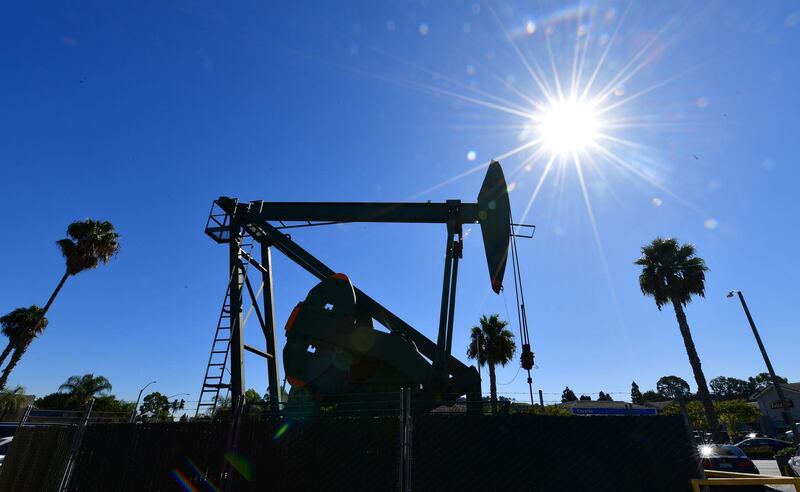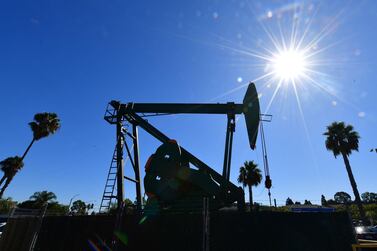West Texas Intermediate, the US oil benchmark, fell to a near 18-year low as the coronavirus pandemic causes country lockdowns that are hitting demand while crude supply surges and shale producers go out of business.
WTI dropped on Sunday to $19.92 (Dh73.16) per barrel but recovered to $20.52 at 2.04pm UAE time on Monday. Meanwhile, Brent, the international crude benchmark was down 7.54 per cent at $23.05 per barrel.
The benchmarks fell as infections from the novel coronavirus surged about 723,000 according to the Johns Hopkins University's tracker.
About 152,000 people have recovered while more than 34,000 people have died from the pandemic. The United States has the highest number of infections globally with more than 143,000 cases.
The virus, which started in Wuhan, led to widespread restrictions in the world's second largest economy as factories ground to a halt, companies suspended operations and employees started to work from home.
The pandemic is the biggest challenge to the global economy since the 2008 financial crisis and has wiped at least $20 trillion (Dh73.4tn) from stock markets worldwide.
The contraction in China's economy, which led to a fall in oil demand, was evident in the country's Purchasing Managers Index for February, which dropped to 35.7 from 50 in January, according to the National Bureau of Statistics. A reading below 50 signals a contraction.
While some factories in China are coming back online again, they may not be working at full capacity. The country has now accumulated an excess supply of oil, which will delay a rebound in demand growth.
In addition to ebbing demand from China, crude prices have also dropped further as a result of the collapse of the Opec+ production pact on deeper cuts.
"Oil markets have now moved into complete dysfunction with prices for physical barrels threatening to go negative," said Daniel Marc Richards, Mena economist at Emirates NBD.
"The possibility of negative prices in the physical market which we alluded to last week looks highly plausible in the current maelstrom."
Prices are hovering in the single digits for specific, largely sulphurous grades of US crude that are difficult to refine.
Prices for Wyoming Asphalt Sour, a crude grade used in bitumen on roads had turned negative, were trading at negative 19 cents per barrel mid-March, signaling wider gloom for the market.
US shale players, who have relatively higher high production costs when compared to the prevailing environment of low oil prices, find it difficult to remain afloat as the world's largest economy goes into virtual shutdown until the end of April. Finding storage for crude and buyers for refined oil is increasingly difficult.
In a sign of the challenging times the 130,000 bpd Come by Chance refinery in Canada's Newfoundland province, said it is shutting down due to the global demand crunch.
Goldman Sachs estimates global consumption will drop 26m bpd, equivalent to a quarter, this week as governments enforce stricter quarantine measures to contain the pandemic.
Landlocked crude production in the US, Russia, and Canada would remain the most vulnerable as the global refining sector reported 900,000 bpd of shut-ins, the bank said in a note.
Economic sentiment remains low, as the global economy slides into a recession. The number of US unemployment claims surged to 3.3 million for the week ending March 21, from 282,000 the previous week, as companies continue to lay off workers.
Oil's retreat further into bearish territory also comes as India, a key oil importer and the world's second-most populous country, imposed a 21-day lockdown last week to contain the spread of the outbreak.
Indonesia, another key oil importer with the world's fourth-largest population, is set to quarantine 30 million people in its capital Jakarta and surrounding areas to contain the pandemic.
The lockdowns come as Saudi Arabia prepares to bring 12.3m barrels per day of supply to the market at the start of April as the Opec+ pact to restrict production expires tomorrow.
The UAE is also expected to bring 4m bpd of supply.
Meanwhile, Riyadh and Moscow appear unlikely to reverse their pump-at-will strategy. Saudi Arabia's energy ministry said last week no contact had been established for "discussion of a joint agreement to balance oil markets".
French bank Credit Agricole's Indosuez Wealth Management does not expect Russia and Saudi Arabia to change course "any time soon".
"We expect that confinement measures related to the Covid-19 virus will continue to weigh on demand, which contracts for the first time since the 2008 financial crisis," the bank said.
The money manager expects WTI to stay below $35 per barrel over the coming months with a recovery towards $45 per barrel only if Chinese demand recuperates in the second half of the year.








